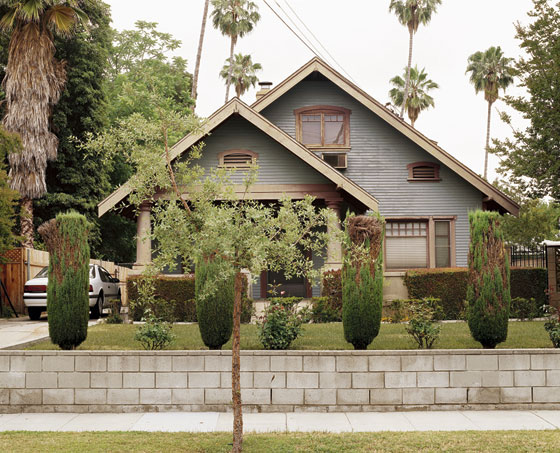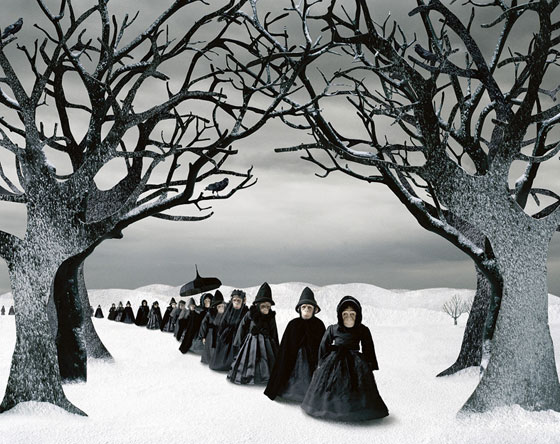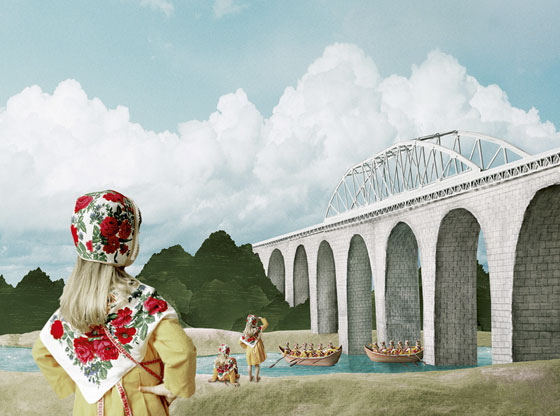|
|
| Playing with realities and realities in play Charlotta Nordström, Art Historian The works of Swedish artists Anna Kleberg, Julia Peirone, Helena Blomqvist and Pernilla Zetterman | |
| Working with photography in art inevitable means taking a conscious grip around perceptions of reality. This never suggests that all photography strive in the same direction, consciously or unconsciously. Instead the possibilities of twisting, turning and extending our minds through the use of photographic images are endless. There is an urge for the viewer of photography to discover what is lost- to recover some kind of hidden reality. This urge exists despite our awareness of historical and social constructions by systems of codes in representation. With this in mind, I would like to present four Swedish artists born in the 1970’s who question the our relationship to the photographic image as a mirror to reality. Swedish artists Anna Kleberg, Julia Peirone, Helena Blomqvist and Pernilla Zetterman have all earned wide recognition in Sweden and internationally. This article points out a few elements, which make their imagery prominent and important for the Swedish art scene. Ranging from strict documentary imagery to surrealistically manipulated pictures, from nostalgia to subtle horror and displacement, the worlds represented in their art stretches existing concepts of surrounding environments. Anna Kleberg lives and works in Stockholm, Sweden. She graduated from University College of Arts Crafts and Design, Department of Photography. Her work has been shown in several group and solo exhibitions. The latest one was called Back and Forth and presented in 2009 at gallery Andréhn-Schiptjenko, Stockholm. It was an installation consisting of photographs, video, paper cut-outs and other objects. The film and photographs represents a woman holding, balancing and being surrounded by boxes, paper and other materials from the artist’s studio. The piece contains references to building blocks and other elements of architecture, which has become signifiers for Kleberg’s work. In this particular work, the artist’s use of photography as a medium for questioning the artistic process is apparent. Kleberg’s photographic work reflects an idea of the documentary by the presentation of objects without any outspoken angle of investigation. They are “just right there”, in front of the viewer who will insist on finding a hidden reality, the image’s optical unconscious. Ignoring the visual element of people as any kind of necessity, many of Kleberg’s images are nevertheless portraits. The series Bungalow Heaven from 2004 show frontal views of Arts and Crafts inspired bungalows built in the early twentieth century in Pasadena, California. The series can be seen as a predecessor to her works Cabanon, featuring Le Corbusier’s mini summerhouse, Superquadras and Cavalos and Bungalows. Because of the straight up way the houses in Bungalow Heaven are photographed, they give a sense of being portraits and the houses are given faces with the help of Kleberg’s camera. The series with bungalows also have a connection to Dan Graham’s series Homes for America from 1962. Both have made their images look like they were taken by a bypassing amateur photographer or a local photo journalist and are similarly concerned with the dreams inhabiting suburban homes. Kleberg’s frontal images of the Pasadena homes also play on the association with low budget advertisement for real estate; buying a new home is equivalent with buying a new, happy life. | |
 Anna Kleberg. Bungalow Heaven No.1. 67x54 cm. 2004 | |
| The play with reality is visible in Kleberg’s images in the picture perfect houses that all look similar, put together from ready-made kits. The homogeneity gives it the character of make-believe and tickles the fascination similar of what a child expresses over a dollhouse. The phenomenon of town models is also explored in Kleberg’s work. Her engagement with housing as “real” and “unreal” surfaces when comparing the sequential series of architecture mentioned above with her images of model towns exhibited in theme parks; The Dutch Model, No 1–8 from Legoland and World Park. Julia Peirone was born in Argentina, raised in Sweden and works today with Stockholm as her base. She received her education from the University College of Art, Craft and Design in Stockholm and the University of Film and Photography in Gothenburg. Peirone has been recognised in Swedish and international press and has for example exhibited her work at Art Basel and Galerie f5.6 in Munich. Her latest solo exhibition entitled Violet Vertigo was shown at Galleri Magnus Åklundh in Malmö in 2010. Peirone’s images are a mix of documentary photography and staging. She uses the immediate concept of reality, which is produced by the camera, deconstructs it into pieces and then rebuilds it to make completely new works. Still, the reality she produces is as real as the reality first caught through the lens of the camera. In Golden Me, the viewer recognises the faces of tough, British teenage girls as raw reality, while at the same time admitting its construction as a montage and as a product of computer based finish. As portraits, the faces of each teenage girl in the photograph, stands on its own and gives us the realness often expected from photography as a medium. In Walter Benjamin’s text on photography from 1931, ‘A Short History of Photography’, he writes: “However skilful the photographer, however carefully he poses his model, the spectator feels an irresistible compulsion to look for the tiny spark of chance, of the here and now, with which reality has, as it were, seared the character in the picture; to find that imperceptible point at which, in the immediacy of that long-past moment, the future so persuasively inserts itself that, looking back, we may rediscover it.” As Benjamin points out, we look to recover something lost in a photograph. In Peirone’s montages it is possible to uncover realities as constructions but at the same time the viewer find comfort in how they seem to mirror familiar identities. The “here and now” connects with something other than the past- Perione’s motifs are placed in “nowhere”. Three series in Peirone’s oeuvre are playfully named after names of cosmetic products aimed at young teenage girls; Violet Vertigo, Blackberry Bloom, Cherry Burst and Electric and Cherry, Honey, Sugar... The use of a black background and strongly lit bodies suggests something frightening in Blackberry Bloom, Cherry Burst and Electric, Broken Me, Golden Me and Black Blondes. Mixed with this feeling of darkness there is also a sense of humour, emerging from Peirone’s way of displacing her subjects, remove the “real” from its original background and painting it black. | |
 Helena Blomqvist. Mourning Procession. 111x134 cm. 2008 | |
| Helena Blomqvist lives and works in Stockholm, Sweden and has a degree in photography from The School of Photography at Gothenburg University. Her latest photographic series The Last Golden Frog was recently shown as a solo show in Malmö and is available in the format of an artist book. As in Peirone’s works, there is something dark about Blomqvist’s images. They speak to our passion for what disturbs us as much as they intrigue us, like a travelling wax cabinet from the 19th century or simply a scary cinematic experience. Montage is also used as a technique in artist Helena Blomqvist’s work. She builds up fantasy worlds as stages using props and models. Digital tools are used to put the last touches on her images, but scenes are already there for the camera to capture. The force of scenography to let the viewer slip into a world of make-believe despite the minds awareness of what is assumed as reality. It is almost a hint to Hinduism’s concepts called “Maya” and “Brahman”– the world is veiled by Maya to create an illusion in front of Brahman, the transcendent reality. Blomqvist’s work often carries a feeling of doom, while flirting with the history of photography, theatre, film and other means of visual representation. The historical references in Blomqvist’s photographic images are not based on what we perceive as true, but they contain codes connoting the past. They create an entrance for the viewer to imagine the past situated in the now. In her piece The Mourning Procession from The Last Golden Frog, a group of figures form a trail, depicted in an isolate landscape against white snow and between naked black trees in the foreground. The trees are revealed as being two dimensional as old fashioned set-pieces on a theatre stage at the same time as the procession gives the image a three dimensional space with depth. The figures, with faces of monkeys, are dressed up in black clothes in a made up Victorian style of the 19th century. This style can easily be connected to the Japanese subculture of Gothic Lolitas, which started in Japan in the late 1990’s. One of the mourning monkeys is even carrying a black parasol- a definite sign for a Gothic Lolita. But why monkeys? Instead of portraying monkeys being ridiculed in human clothing, maybe Blomqvist offers a glimpse into an alternative now where monkeys play our part in society? We long to replace our reality for a moment and theatre is a result of this. Just like theatre, we clearly see the illusion in Blomqvists images and at the same time our will to forget what is real to us becomes overwhelming. References to the 19th century are recurrent in Blomqvist’s work. Her photographs of people in the series of the The Dark Planet, The Last Golden Frog and her latest work Down By The River I and II all resemble photographs which have been retouched by hand with bright colours. This was a fashionable technique in the late 1800’s, which Benjamin referred to as a fad belonging to the “imperialist bourgeoisie”. But this technique was widespread in the European visual culture at this time. Montages with retouching could be seen in images and postcards around fin de siècle 1900, creating scenes from fairytales and mythological figures by painting on photographs of women and children. Blomqvist’s work never seem detached from the western history of photography and visual culture- it is a strong reflection of it. | |
 Helena Blomqvist. Down by the River. 138x174 cm. 2009 | |
| Pernilla Zetterman lives and works in Stockholm, Sweden. She studied photography in Sweden and Finland and is as much part of the Finish art scene as the Swedish. Zetterman participates with her work in the well-reputed project The Helsinki School and the touring exhibition, “Photography and Video NOW” during 2010. In her first monograph published in 2010, Behave, Pernilla Zetterman presents two of her photographic series; When and Ground Rules. In When, Zetterman studies three generations of women and part of the series is photographed in her grandmother’s home, her mother’s and her own, where she turns inside and out of objects found in the very near environment of each person. The sense of closeness makes a connection between Zetterman’s different series of work. In Ground Rules, she zooms in on the track and field athlete in a similar way as the women in When. Carefully and with a strong, investigating gaze, Zetterman takes close-ups of details that are important in the shaping of different identities. The complicated relationships between distance and closeness, discipline and tenderness find a balance as well as a tension in Zetterman’s images. This creates parallels between the mother-daughter relationship and the athlete’s sense of knowing his or her body. The same can be said about her representations of equestrian culture in the series Close. The viewers of these photographs are lifted into worlds where integrity is greatly valued and high achievement lies in finding the key to controlling your own or someone else’s body. In the series Grammar, Zetterman turns to bodies and letters as signs to explore questions of language, communication and codification. From a study of dyslexia she has used word combinations and reproduced them through screen-printing and the use of dancers bodies. Zetterman’s images have a documentary notion about them, but they are presented as a mixture between fact and fiction. The possibility of objectivity is ruled out in her imagery and replaced with exposed deconstructions of reality. | |
| go back | |







